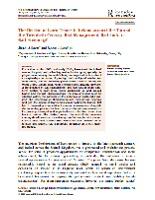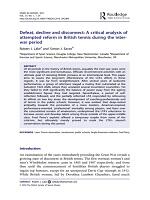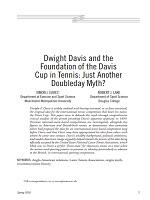Eaves, Simon J.
Person Preferred Name
Simon J. Eaves
Related Works
Content type
Digital Document
Abstract
For a time in the 1880s and early 1890s, lawn tennis in Ireland was at its peak, and a leading nation in the sport, globally. Its players were among the world’s best, the only rival to its national championships in terms of prestige and quality of entries was Wimbledon, and its coaching professionals ranked among the world’s most sought after. From the mid-1890s onwards, however, a combination of bad management and bad luck brought long-term decline to Irish lawn tennis, particularly in and around Dublin and the Irish Championships. The story of decline must be situated within the contexts of the desertion of aristocratic support, the emergence of alternative leisure pursuits like bicycling and golf, the spread of lawn tennis across continental Europe that led to increasing competition between tournaments, alongside the mounting pressure for lawn tennis clubs and tournaments to be properly managed and organized as a collective, rather than isolated entities. This decline around the turn of the twentieth century should serve as a cautionary tale for how broader circumstances, only some of which were under the direct influence of its officials and leaders, had a profound influence on a rich, sporting culture.
Origin Information
Content type
Digital Document
Abstract
Within the historiography of lawn tennis in Ireland, there remains considerable scope to discern how the sport rose to prominence – reaching its apex in the early 1890s – among the wealthy landed classes, and what influence it had upon the structure and culture of the sport globally. This is set against the assumed view of lawn tennis being a rather marginal sport during the late-nineteenth century when the fight for popularity between native Irish and British team sports dominated media narratives. Separated from much of this commotion, lawn tennis helped to forge landed aristocratic/gentry identity within urban/suburban locales across Ireland – principally in Dublin, where its leading clubs and championship were regarded almost on a par with its equivalents in London – and also emancipate Irish sportswomen, and a small number of working-class coaching-professionals who plied their trade in the leading clubs. Given the broader historical context of increasing land agitation and subsequent rising Irish populist nationalism, the growth of lawn tennis in itself remains an interesting phenomenon. Thus, the brief rise to prominence of tennis in Ireland, and specifically Dublin, is examined, contextualized within broader socio-cultural and politico-religious developments that pervaded the organization of Irish society, and British-Irish relations, during this time.
Origin Information
Content type
Digital Document
Abstract
In the context of sustained imperial dominance during the late Victorian era, foreigners perceived British playing styles, methods and approaches to lawn tennis as ‘blueprints’ for aspiring players. Those seeking to learn the game were largely dependent on observing skilled performers, however before the mid-1890s, most of the best British players declined to venture to Australasia and America, perceiving the opposition as inferior and their championships unworthy of their participation. Moreover, while British-trained coaching-professionals – widely considered the world’s best – offered instruction in a small number of clubs, they also rarely ventured outside of Europe. Alongside these barriers, the parochial and ethnocentric Lawn Tennis Association was less than proactive in their approaches to fostering international relations. One man, however, Dr Wilberforce Vaughan Eaves, did more for the internationalization of the sport than anyone else during this period, travelling extensively in America, South Africa and Australasia, demonstrating his skills, offering instruction and advising officials. Consequently, he helped develop the sport’s international character, laying the foundations for the Davis Cup, helping to foster Anglo-Australasian and Anglo-American relations, and hastening the development of foreign players, particularly in Australasia. This paper assesses the notable contributions of a player, coach and diplomat who has been largely ignored.
Origin Information
Content type
Digital Document
Abstract
Of all periods in the history of British tennis, arguably the inter-war years were the most significant and tumultuous. Officials recommenced activities with an ultimate goal of restoring British prowess at an international level. This paper aims to assess the long-term effectiveness of the LTA’s efforts in these regards. It was far from straightforward. After several years of lacklustre performances, a group of reformers staged a mutiny that culminated at the turbulent 1922 AGM, where they unseated several incumbent councillors. Yet they failed to shift significantly the balance of power away from the ageing establishment figures they had targeted. Nevertheless, a period of self-reflection followed, and the partially reformed LTA responded by refocusing its efforts on two key areas: the development of coaching-professionals and of tennis in the public schools. However, it was evident that deep-rooted antipathy towards the promotion of a more modern, American-inspired, performance-oriented, 'professional' mentality among players, and fears over the concomitant erosion of amateurism, underpinned the LTA’s reluctance to increase access and develop talent among those outside of the upper-middle class. Fred Perry’s exploits offered a temporary respite from some of the criticism, but ultimately merely proved to mask the LTA’s staunch conservatism during this period.
Origin Information
Content type
Digital Document
Abstract
Dwight F. Davis is widely credited with having invented, or at least conceived, the original idea for the international tennis competition that bears his name, the Davis Cup. This paper aims to debunk this myth through comprehensive critical analysis of the period preceding Davis's apparent epiphany in 1899. Previous national-team-based competitions are investigated, alongside key figures in American and British/Irish tennis, to demonstrate that numerous others had proposed the idea for an international team-based competition long before Davis and that Davis may have appropriated his idea from others with whom he came into contact. Davis's wealthy background, political ambitions, and model-American image arguably helped smooth the process of his idea being officially accepted by the United States National Lawn Tennis Association, which likely saw in Davis a perfect "frontman" for American tennis at a time when the nation used sporting prowess to promote its identity, particularly in relation to the British, in international sporting competition.
Origin Information
Content type
Digital Document
Abstract
Anglo-American relations in tennis are a fascinating subject, particularly in the period of the late-19th/early-20th century, during which on- and off-court developments reflected and indicated broader societal shifts, as the US gradually replaced Britain as the world’s leading industrialized nation. This paper aims to discuss how Anglo-American relations in lawn tennis shifted throughout this period, from when lawn tennis was “invented” in Britain to the onset of the Great War, and to contextualize these developments in the light of shifting broader cultural relations more generally between both nations, alongside developments within sport and tennis more specifically. The following aspects are examined: attitudes toward the relative standards of both American and British players from correspondents of both nations in terms of their overall rank and possibilities of success; and, attitudes from tennis officials toward the formal organization of competitions between players of both nations.
Origin Information
Content type
Digital Document
Abstract
This article examines the lives of the late-nineteenth and early-twentieth-century lawn tennis coaching-professionals, notably Tom Burke, Harry Cowdrey, Charles Haggett and George Kerr. These men, considered equally if not more gifted than the first-ranked amateur players of the period, have received scant attention or recognition, either as “expert” players or for their role as coaches/instructors within the “amateur” game. Ostensibly, these working-class boys/men sought employment in clubs, as ball-boys, groundskeepers, stringers and instructors, but, being immediately classified as “professionals”, were subsequently marginalised within clubs and barred from amateur competitions. Few outside of the club environs encountered them, few observed or learned of their skills, and fewer still reported their exploits. While many of the top amateur players of the period recognised the need for coaching-professionals, the British Lawn Tennis Association (LTA) was intransigent. They staunchly refused to sanction professional competitions in Britain, fearing they would provide a pathway away from amateurism, and propel the amateur to seek remuneration from their tennis. Coaching-professionals had little choice but to remain as “servants” within their clubs, confined by the rigid class system and unyielding amateur ethos. Hitherto largely ignored within lawn tennis historiography, these men are the “ghosts” of lawn tennis past.
Origin Information







